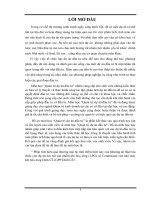Course “quản trị dự án đầu tư
Bạn đang xem bản rút gọn của tài liệu. Xem và tải ngay bản đầy đủ của tài liệu tại đây (26.73 MB, 96 trang )
<span class="text_page_counter">Trang 1</span><div class="page_container" data-page="1">
<b>COURSE: “QUẢN TRỊ DỰ ÁN ĐẦU TƯ”</b>
<i><b>Lecturer: MSc. Doan Anh Tuan VJCC Institute Foreign Trade University</b></i>
<b>-Section 1: Introduction toProject Management</b>
</div><span class="text_page_counter">Trang 3</span><div class="page_container" data-page="3"><b>1 The definition of Project2 Project Life Cycles</b>
<b>3 Determinants of Project Success4 Project Management Maturity5 Employability Skills</b>
<b>6 Group discussion7 Key takeaways</b>
</div><span class="text_page_counter">Trang 7</span><div class="page_container" data-page="7"><b>THE DEFINITION OF PROJECT</b>
1
</div><span class="text_page_counter">Trang 9</span><div class="page_container" data-page="9">THE DEFINITION OF PROJECT
<small>- It is recognized thatprojects are distinct from otherorganizational processes.As arule,aprocess refers toongoing, day- -to day activities in which an organizationengages while producing goods or services. Processes useexistingsystems,properties,andcapabilitiesinacontinuous, fairly repetitive manner. Projects, on the otherhand, take place outside the normal, process-oriented worldof the firm.</small>
<small>- A project is a unique venture witha beginning and end,conducted by people to meet established goals withinparameters of cost, schedule, and quality.</small>
<small>- Projects aregoal oriented-, involve the coordinatedundertaking of interrelated activities, are of finite duration,and are all, to a degree, unique.</small>
<small>- In the PMBoK (Project Management Body of Knowledge)guide, a project is defined as“a temporary endeavorundertaken to create a unique product, service, or result”.</small>
</div><span class="text_page_counter">Trang 11</span><div class="page_container" data-page="11">THE DEFINITION OF PROJECT
<i><b>* Projects are complex, one-timeprocesses.</b></i>
- A project arises for a specific purpose or to meet a stated goal. It is complex because it typically requires the coordinated input of numerous members of the organization. Project members may be from different departments, other organizational units, or one functional area.
- Because a project is intended to fulfill a stated goal, it is temporary. It exists only until its goal has been met, and at that point it is dissolved.
</div><span class="text_page_counter">Trang 13</span><div class="page_container" data-page="13">THE DEFINITION OF PROJECT
<i><b>*Projectsarelimitedbybudget,schedule, and resources</b></i>
- Project work requires that members work with limited financial and human resources for a specified time period. They do not run indefinitely.
- Once the assignment is completed, the project team disbands. Until that point, all its activities are constrained by limitations on budget and personnel availability. - Projects are “resource constrained” -activities.
</div><span class="text_page_counter">Trang 15</span><div class="page_container" data-page="15">THE DEFINITION OF PROJECT
<i><b>* Projects are developed to resolve a clear goal or set of goals.</b></i>
- There is no such thing as a project team with an ongoing, nonspecific purpose. project’s goals, or deliverables, define the nature of both the project and its team.
</div><span class="text_page_counter">Trang 17</span><div class="page_container" data-page="17">THE DEFINITION OF PROJECT
<i><b>* Projects are customer-focused</b></i>
- Whether the project is responding to the needs of an internal organizational unit or intended to exploit a market opportunity external to the organization, the underlying purpose of any project is to satisfy customer needs.
- In the past, this goal was sometimes overlooked. Projects were considered successful if they attained technical, budgetary, and scheduling goals. More and more, however, companies have realized that the primary goal of a project is customer satisfaction.
</div><span class="text_page_counter">Trang 19</span><div class="page_container" data-page="19">THE DEFINITION OF PROJECT
<i><b>GENERAL PROJECT CHARACTERISTICS</b></i>
1. Projects are ad hoc endeavors with a clear life cycle
2. Projects are building blocks in the design and execution of organizational strategies 3. Projects are responsible for the newest and most improved products, services, a
organizational processes
4. Projects provide a philosophy and strategy for the management of change 5. Project management entails crossing functional and organizational boundaries
6. The traditional management functions of planning, organizing, motivation, directing and control apply to project management
7. The principal outcomes of a project are the satisfaction of customer requirements with the constraints of technical, cost, and schedule objectives
8. Projects are terminated upon successful completion of performance objectives
</div><span class="text_page_counter">Trang 21</span><div class="page_container" data-page="21">THE DEFINITION OF PROJECT
<i><b>Project Case study: Royal Mail (Moving with the Times)</b></i>
</div><span class="text_page_counter">Trang 23</span><div class="page_container" data-page="23">THE DEFINITION OF PROJECT
<i><b>THE IMPORTANCE OF PROJECTS</b></i>
1. Shortened product life cycles 2. Narrow product launch windows 3. Increasingly complex and technical
4. Global markets
5. An economic period marked by low inflation
</div><span class="text_page_counter">Trang 25</span><div class="page_container" data-page="25">THE DEFINITION OF PROJECT
<i><b>Project Case study: London’s Crossrail (Europe’s Largest Construction Project)</b></i>
</div><span class="text_page_counter">Trang 27</span><div class="page_container" data-page="27"><b>PROJECT LIFE CYCLES</b>
2
</div><span class="text_page_counter">Trang 29</span><div class="page_container" data-page="29">PROJECT LIFE CYCLES
- A project life cycle refers to the stages in a project’s development.
- Life cycles are important because they demonstrate the logic that governs a project. - They also help us develop our plans for carrying out the project. They help us decide, for example, when we should devote resources to the project, how we should evaluate its progress, and so forth.
-> The simplified model divides the life cycle into four distinct phases:
<i><b>Conceptualization,Planning,Execution,and Termination.</b></i>
<small>PROJECT LIFE CYCLE STAGES</small>
</div><span class="text_page_counter">Trang 31</span><div class="page_container" data-page="31">PROJECT LIFE CYCLES
<i><b>* Conceptualization </b></i>
- It refers to the development of the initial goal and technical specifications for a project.
- The scope of the work is determined, necessary resources (people, money, physical plant) identified, and important
organizational contributors or stakeholders signed on.
<small>PROJECT LIFE CYCLE STAGES</small>
</div><span class="text_page_counter">Trang 33</span><div class="page_container" data-page="33">PROJECT LIFE CYCLES
<i><b>* Planning </b></i>
- It is the stage in which all detailed specifications, schematics, schedules, and other plans are developed.
- The individual pieces of the project, often called <i><b>work packages</b></i>, are broken down, individual assignments made, and the process for completion clearly delineated.
<small>PROJECT LIFE CYCLE STAGES</small>
</div><span class="text_page_counter">Trang 35</span><div class="page_container" data-page="35">PROJECT LIFE CYCLES
<i><b>* Execution</b></i>
- During execution, the actual “work” of the project is performed, the system developed, or the product created and fabricated. It is during the execution phase that the bulk of project team labor is performed.
- Project costs (in man hours) ramp up rapidly during this stage.
<small>PROJECT LIFE CYCLE STAGES</small>
</div><span class="text_page_counter">Trang 37</span><div class="page_container" data-page="37">PROJECT LIFE CYCLES
<i><b>* Termination</b></i>
- Termination occurs when the completed project is transferred to the customer, its resources reassigned, and the project formally closed out.
- As specific sub activities are completed, the project shrinks in scope and costs decline rapidly.
<small>PROJECT LIFE CYCLE STAGES</small>
</div><span class="text_page_counter">Trang 39</span><div class="page_container" data-page="39">PROJECT LIFE CYCLES
<i><b>5components ofaproject may change over the course of its life cycle:</b></i>
<i><b>- Client interest:</b></i> The level of enthusiasm or concern expressed by the project’s intende customer. Clients can be either internal or external to the organization.
<i><b>- Project stake:</b></i>The amount of corporate investment in the project. The longer the life of th project, the greater the investment.
<i><b>- Resources:</b></i> The commitment of financial, human, and technical resources over the life the project.
<i><b>- Creativity:</b></i> The degree of innovation required by the project, especially during certa development phases.
<i><b>- Uncertainty:</b></i> The degree of risk associated with the project. Riskiness here reflects th number of unknowns, including technical challenges that the project is likely to fa Uncertainty is highest at the beginning because many challenges have yet to be identif let alone addressed.
</div><span class="text_page_counter">Trang 41</span><div class="page_container" data-page="41">PROJECT LIFE CYCLES
- The components are useful for developing a sense of the competing issues and challenges that a project team is likely to face over the life cycle of a project.
- Over time, while certain characteristics (creativity, resources, and uncertainty) begin to decrease, other elements (client interest and project stake) gain in importance.
- Balancing the requirements of these elements across the project life cycle is just one of the many demands placed on a project team.
<small>PROJECT LIFE CYCLE AND ITS EFFECTS</small>
</div><span class="text_page_counter">Trang 43</span><div class="page_container" data-page="43"><b>DETERMINANTS OF PROJECT SUCCESS</b>
3
</div><span class="text_page_counter">Trang 45</span><div class="page_container" data-page="45"><b>DETERMINANTS OF PROJECT SUCCESS</b>
- Any definition of project success must take into consideration the elements that define the very nature of a project: that is, time (schedule adherence), budget, functionality/quality, and customer satisfaction.
- We can also think of the criteria for project success in terms of internal versus external conditions.
<small>THE NEW QUADRUPLE CONSTRAINT</small>
</div><span class="text_page_counter">Trang 47</span><div class="page_container" data-page="47"><b>DETERMINANTS OF PROJECT SUCCESS</b>
<i><b>* Time</b></i>
- Projects are constrained by a specified period of time during which they must be completed. They are not supposed to continue indefinitely.
- Thus, the first constraint that governs project management involves this basic requirement: The project should come in on or before its established schedule.
</div><span class="text_page_counter">Trang 49</span><div class="page_container" data-page="49"><b>DETERMINANTS OF PROJECT SUCCESS</b>
<i><b>* Budget</b></i>
A second key constraint for all projects is a limited
budget. Projects must meet budgeted allowances in order to use resources as efficiently as possible. Companies do not write blank checks and hope for the best.
</div><span class="text_page_counter">Trang 51</span><div class="page_container" data-page="51"><b>DETERMINANTS OF PROJECT SUCCESS</b>
<i><b>* Performance</b></i>
- All projects are developed in order to adhere to some initially determined technical specifications. Measuring performance, then, means determining whether the finished product operates according to specifications.
- The project’s clients naturally expect that the project being developed on their behalf will work as expected. Applying this third criterion is often referred to as conducting a quality check.
</div><span class="text_page_counter">Trang 53</span><div class="page_container" data-page="53"><b>DETERMINANTS OF PROJECT SUCCESS</b>
<i><b>* Client acceptance</b></i>
- The principle of client acceptance argues that projects are developed with customers or clients in mind, and their purpose is to satisfy
customers’ needs.
- If client acceptance is a key variable, then we must also ask whether the completed project is acceptable to the customer for whom it was intended.
</div><span class="text_page_counter">Trang 55</span><div class="page_container" data-page="55"><b>DETERMINANTS OF PROJECT SUCCESS</b>
- An additional approach to project assessment argues that another factor must always taken into consideration: the promise that the delivered product can generate futu opportunities, whether commercial or technical, for the organization. In other words, it not enough to assess a project according to its immediate success. We must also evaluat in terms of its commercial success as well as its potential for generating new business new opportunities. Below are four relevant dimensions of success:
<i><b>Project efficiency:</b></i>Meeting budget and schedule expectations.
<i><b>Impact on customer:</b></i> Meeting technical specifications, addressing customer needs, and creating a project that satisfies the client’s needs.
<i><b>Business success:</b></i> Determining whether the project achieved significant commercial success.
<i><b>Preparing for the future:</b></i> Determining whether the project opened new markets or new product lines or helped to develop new technology.
</div><span class="text_page_counter">Trang 57</span><div class="page_container" data-page="57"><b>DETERMINANTS OF PROJECT SUCCESS</b>
Corporations expect projects not only to be run efficiently, at the least, but also to be developed to meet customer needs, achieve commercial success, and serve as conduits to new business opportunities.
</div><span class="text_page_counter">Trang 59</span><div class="page_container" data-page="59"><b>PROJECT MANAGEMENT MATURITY</b>
4
</div><span class="text_page_counter">Trang 61</span><div class="page_container" data-page="61"><b>PROJECT MANAGEMENT MATURITY</b>
- Project management maturity models are used to allow organizations to benchmark the best practices of successful project management firms. Project management maturity models recognize that different organizations are currently at different levels o sophistication in their best practices for managing projects.
- The purpose of benchmarking is to systematically manage the process improvements project delivery by a single organization over a period of time.
<i><b>- Maturity models provide the necessary framework to: first, analyze and critically evaluatcurrent practices as they pertain to managing projects; second, compare those practiceagainst those of chief competitors or some general industry standard; and, third, define</b></i>
systematic route for improving these practices.
</div><span class="text_page_counter">Trang 63</span><div class="page_container" data-page="63"><b>PROJECT MANAGEMENT MATURITY</b>
Spider Web Diagram for Measuring Project Maturity
</div><span class="text_page_counter">Trang 65</span><div class="page_container" data-page="65"><b>EMPLOYABILITY SKILLS</b>
5
</div><span class="text_page_counter">Trang 67</span><div class="page_container" data-page="67">EMPLOYABILITY SKILLS
- Communication is defined as effective use of oral, written, and nonverbal communication skills for multiple purposes, such as to inform, instruct, motivate, persuade, and share ideas. - It also includes effective listening, using technology to communicate, and being able to evaluate the effectiveness of communication efforts—all within diverse contexts.
</div><span class="text_page_counter">Trang 69</span><div class="page_container" data-page="69">EMPLOYABILITY SKILLS
<i><b>CRITICAL THINKING</b></i>
- Critical thinking involves purposeful and goal-directed thinking used to define and solve problems, make decisions, or form judgments related to a particular situation or set of circumstances.
- For successful project managers, critical thinking is a critical skill.
</div><span class="text_page_counter">Trang 71</span><div class="page_container" data-page="71">EMPLOYABILITY SKILLS
Collaborative learning is a situation in which individuals actively work together on a task, constructing meaning and knowledge as a group through dialogue and negotiation resulting in a final product reflective of their joint, interdependent actions.
</div><span class="text_page_counter">Trang 73</span><div class="page_container" data-page="73">EMPLOYABILITY SKILLS
<i><b>KNOWLEDGE APPLICATION AND ANALYSIS</b></i>
Knowledge application and analysis is the ability to learn a concept and then appropriately apply that knowledge in another setting to achieve a higher level of understanding.
</div><span class="text_page_counter">Trang 75</span><div class="page_container" data-page="75">EMPLOYABILITY SKILLS
<i><b>BUSINESSETHICSANDSOCIAL RESPONSIBILITY</b></i>
- Business ethics are sets of guiding principles that influence the way individuals and organizations behave within the society in which they operate. - Corporate social responsibility (CSR) is a form of ethical behavior that requires that organizations understand, identify, and eliminate unethical eco-nomic, environmental, and social behaviors.
</div><span class="text_page_counter">Trang 77</span><div class="page_container" data-page="77">EMPLOYABILITY SKILLS
<i><b>INFORMATIONTECHNOLOGYAPPLICATION AND COMPUTINGSKILLS</b></i>
- Information technology application and computing skills are the ability to select and use appropriate technology to accomplish a given task.
- The individual is also able to apply computing skills to solve problems and show proficiency with computer software programs.
</div><span class="text_page_counter">Trang 79</span><div class="page_container" data-page="79">EMPLOYABILITY SKILLS
<i><b>DATA LITERACY</b></i>
- Data literacy is the ability to access, assess, interpret, manipulate, summarize, and communicate data.
- One of the challenges of successful project management is the need to have equal facility in soft skills of project team development and leadership as well as computational abilities that allow us to understand financial models for project selection, cost accounting principles, scheduling and network development, resource management, and evaluation and control.
</div><span class="text_page_counter">Trang 81</span><div class="page_container" data-page="81"><b>GROUP DISCUSSION</b>
6
</div><span class="text_page_counter">Trang 83</span><div class="page_container" data-page="83">GROUP DISCUSSION
<i><b>Explore the case ofDisney’s Expedition Everest</b></i>
<i><b>and answer the following questions:</b></i>
1. Suppose you were a project manager for Disney. Based on the information in this case, what critical success metrics do you think the company uses when designing a new ride? That is, how would you prioritize the needs for addressing project cost, schedule, quality, and client acceptance? What evidence supports your answer?
2. Why is Disney’s attention to detail in its rides unique? How does the company use the “atmosphere” discussed in the case to maximize the experience while minimizing complaints about the length of wait for the ride?
</div><span class="text_page_counter">Trang 85</span><div class="page_container" data-page="85"><b>KEY TAKEAWAYS</b>
7
</div><span class="text_page_counter">Trang 87</span><div class="page_container" data-page="87">KEY TAKEAWAYS
<small>1. Project management offers organizations a number of practical competitive advantages, including tability to be both effective in the marketplace and efficient with the use of organizational resourcalso offers the ability to achieve technological breakthroughs, to streamline new-product developmeand to manage the challenges arising from the business environment.</small>
<small>2. Projects operate outside of nor- mal organizational processes, typified by the work done by functiorganizational units. Because they are unique, they require a different mind-set, one that is temporand aimed at achieving a clear goal within a limited time frame. Projects are ad hoc endeavors wclear life cycle. They are employed as the building blocks in the design and execution of organizatstrategies, and they provide a philosophy and a strategy for the management of change. Other reaswhy they are a challenge include the fact that project management requires the crossing of functiand organizational boundaries while trying to satisfy the multiple constraints of time, bud g-functionality, and customer satisfaction.</small>
</div>








